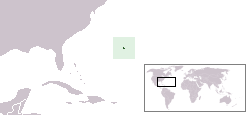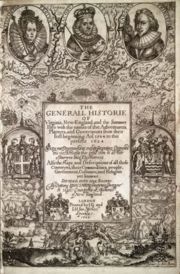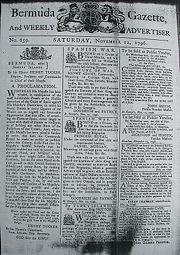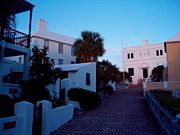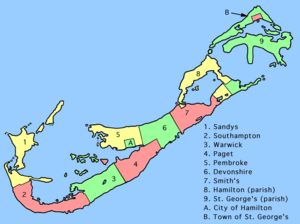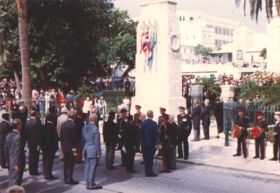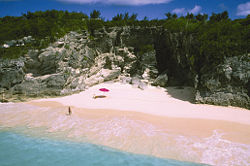Bermuda
2008/9 Schools Wikipedia Selection. Related subjects: Americas; Countries
| Bermuda | ||||||
|---|---|---|---|---|---|---|
|
||||||
| Motto: "Quo Fata Ferunt" (Latin) "Whither the Fates Carry [Us]" |
||||||
| Anthem: God Save the Queen (official) Hail to Bermuda (unofficial) |
||||||
|
|
||||||
| Capital (and largest city) |
Hamilton |
|||||
| Official languages | English | |||||
| Ethnic groups | West African, British, Portuguese | |||||
| Demonym | Bermudian | |||||
| Government | British Overseas Territory | |||||
| - | Monarch | Queen Elizabeth II | ||||
| - | Governor | Sir Richard Gozney | ||||
| - | Premier | Ewart Brown | ||||
| Area | ||||||
| - | Total | 53.3 km² ( 224th) 20.6 sq mi |
||||
| - | Water (%) | 26% | ||||
| Population | ||||||
| - | 2007 estimate | 66,163 ( 205th1) | ||||
| - | Density | 1,239/km² ( 8th) 3,196/sq mi |
||||
| GDP ( PPP) | 2005 estimate | |||||
| - | Total | $4.857 billion ( 165th) | ||||
| - | Per capita | $76,403 ( 1st) | ||||
| HDI (2003) | n/a (n/a) ( n/a) | |||||
| Currency | Bermudian dollar2 ( BMD) |
|||||
| Time zone | Atlantic ( UTC-4) | |||||
| Internet TLD | .bm | |||||
| Calling code | +1 441 | |||||
| 1 | Rank based on 2005 figures. | |||||
| 2 | On par with US dollar. | |||||
Bermuda (officially, The Bermuda Islands or The Somers Isles) is a British overseas territory in the North Atlantic Ocean. Located off the east coast of the United States, it is situated around 1770 kilometres (1,100 mi) northeast of Miami, Florida, and 1350 kilometres (840 mi) south of Halifax, Nova Scotia, Canada. The nearest landmass is Cape Hatteras, North Carolina, about 1030 kilometres (640 mi) west-northwest. It is the oldest and most populous remaining British overseas territory, settled by England a century before the Acts of Union created the United Kingdom.
Although commonly referred to in the singular, the territory consists of approximately 138 islands, with a total area of 53.3 square kilometres (20.6 sq mi). Compiling a list of these islands is often complicated, as many have more than one name (as does the entire archipelago, which, in addition to its two official names, has historically been known as "La Garza", "Virgineola", and the "Isle of Devils"). Despite the limited land mass, there has also been a tendency for place names to be repeated; there are, for instance, two islands named "Long Island", three bays known as "Long Bay", and " St. George's Town" is located on " St. George's Island" within " St. George's Parish" (each known as St. George's), whereas Bermuda's capital, the "City of Hamilton", lies in Pembroke Parish, not in "Hamilton Parish", on the largest island, "Main Island", which itself is sometimes called "Bermuda".
Bermuda has a highly affluent economy, with a large financial sector and tourism industry giving it the world's highest GDP per capita in 2005. It has a subtropical climate, beaches with pink sand, and cerulean blue ocean.
History
Bermuda was discovered by Europeans in the early 1500s, probably in 1503, according to some sources. It was certainly known by 1511, when Peter Martyr d'Anghiera published his Legatio Babylonica, which mentioned Bermuda, and the island was also included on Spanish charts of this year. The discovery is attributed to a Spanish explorer, Juan de Bermúdez. Both Spanish and Portuguese ships used the islands as a replenishment spot for fresh meat and water, but legends of spirits and devils, now thought to have stemmed only from the callings of raucous birds (most likely the Bermuda Petrel, or Cahow), and of perpetual, storm-wracked conditions (most early visitors arrived under such conditions), kept them from attempting any permanent settlement on the Isle of Devils.
Bermúdez and Gonzalo Fernández de Oviedo ventured to Bermuda in 1514 or 1515 with the intention to drop off a breeding stock of hogs on the island as a future stock of fresh meat for passing ships. However, the inclement weather prevented them from landing.
Some years later, a Portuguese ship on the way home from San Domingo wedged itself between two rocks on the reef. The crew tried to salvage as much as they could and spent the next four months building a new hull from Bermuda cedar to return to their initial departure point. One of these stranded sailors is most likely the person who carved the initials "R" and "P", "1543" into Spanish Rock. The initials probably stood for "Rex Portugaline" and later were incorrectly attributed to the Spanish, leading to the misnaming of this rocky outcrop of Bermuda.
For the next century, the island is believed to have been visited frequently but not permanently settled. The first two British colonies in Virginia had failed, and a more determined effort was initiated by King James I of England (and VI of Scotland), who granted a Royal Charter to The Virginia Company. In 1609, a flotilla of ships left England under the Company's Admiral, Sir George Somers, to relieve the colony of Jamestown, settled two years before. Somers had previous experience sailing with both Sir Francis Drake and Sir Walter Raleigh. The flotilla was broken up by a storm, and the flagship, the Sea Venture, was wrecked off Bermuda (as depicted on the territory's Coat of Arms), leaving the survivors in possession of a new territory. (William Shakespeare's play The Tempest is thought to have been inspired by William Strachey's account of this shipwreck.) The island was claimed for the English Crown, and the charter of the Virginia Company was extended to include it. In 1615, the colony was passed to a new company, the Somers Isles Company (The Somers Isles remains an official name for the colony), formed by the same shareholders. The close ties with Virginia were commemorated even after Bermuda's separation by reference to the archipelago in many Virginian place names, such as Bermuda City, and Bermuda Hundred. The first British coins in America were struck here.
Most of the survivors of the Sea Venture had carried on to Jamestown in 1610 aboard two Bermuda-built ships. Among these was John Rolfe, who left a wife and child buried in Bermuda, but in Jamestown would marry Pocahontas, a daughter of Powhatan. Rolfe was also single-handedly responsible for beginning Virginia's tobacco industry (the economic basis of the colony had been intended to be lumber). Intentional settlement of Bermuda began with the arrival of the Plough, in 1612.
With its limited land area, Bermuda has had difficulty since then with its population growth. In the first two centuries of settlement, it relied on steady emigration to keep the population manageable. Before the American Revolution, more than ten thousand Bermudians emigrated, primarily to the American South, where Great Britain was displacing Spain as the dominant European imperial power. A steady trickle of outward migration continued as, by the end of the 18th century, with seafaring being the only real industry, at least a third of the island's manpower was at sea at any one time. This limited land area and resources led to the creation of what may have been the earliest conservation laws of the New World, when in 1616 and 1620 Acts were passed banning the hunting of certain birds and young tortoises
In 1649, the English Civil War raged and King Charles I was beheaded in Whitehall, London. The execution resulted in the outbreak of a Bermudian Civil War; it was ended by embodied militias. This created a strong sense of devotion to the crown for the majority of colonists and it forced those who would not swear allegiance, such as Puritans and Independents, into exile in the Bahamas.
In the 17th century, the Somers Isles Company suppressed shipbuilding as it needed Bermudians to farm if it were to generate income from the land. Agricultural production met with only limited success, however. The Bermuda cedar boxes used to ship tobacco to England were reportedly worth more than their contents. The colony of Virginia far surpassed Bermuda in both quality and quantity of tobacco produced. After the dissolution of the Somers Isle Company, Bermudians rapidly abandoned agriculture for shipbuilding, replanting farmland with the native juniper ( Juniperus bermudiana, also called Bermuda cedar) trees that grew thickly over the whole island. Establishing effective control over the Turks Islands, Bermudians deforested their landscape to begin the salt trade that would become the world's largest, and remained the cornerstone of Bermuda's economy for the next century. Bermudian sailors would turn their hands to far more trades than supplying salt, however. Whaling, privateering, and the merchant trade were all pursued vigorously. Vessels would sail the normal shipping routes, but had to engage an enemy vessel no matter the size or strength, and as a result many ships were destroyed. The Bermuda sloop became highly regarded for its speed and manoeuvrability. In fact it was the Bermuda sloop HMS Pickle, one of the fastest vessels in the Royal Navy, that brought the news of the victory at Trafalgar and the death of Admiral Nelson back to England.
After the American Revolution, the Royal Navy began improving the harbours and built the large dockyard on Ireland Island, in the west of the chain, as its principal naval base guarding the western Atlantic Ocean shipping lanes. During the American War of 1812, the British attacks on Washington D.C. and the Chesapeake, that would result in the writing of " The Star-Spangled Banner", were planned and launched from Bermuda, the Royal Navy's 'North American Station'. It was here that the British soldiers assembled before being sent to attack Baltimore and Washington. In 1816, Bermuda's Royal Naval Dockyard was fortified against possible US attacks by James Arnold. Arnold was the son of famed US traitor Benedict Arnold. Today, the "Maritime Museum" occupies on the Keep of the Royal Naval Dockyard, including the Commissioner's House, and exhibits artifacts of the base's military history.
As a result of Bermuda's proximity to the southeastern U.S. coast, it was regularly used by Confederate States blockade runners during the American Civil War to evade Union naval vessels and bring desperately needed war goods to the South from England. The old Globe Hotel in St. George's, which was a centre of intrigue for Confederate agents, is preserved as a museum open to the public.
In the early 20th century, as modern transport and communication systems developed, Bermuda became a popular destination for wealthy American, Canadian and British tourists. In addition, the Smoot-Hawley Tariff Act enacted by the United States against its trading partners in 1930 cut off Bermuda's once-thriving agricultural export trade (primarily fresh vegetables to the US) spurring the overseas territory to develop its tourist industry, which is second behind international business in terms of economic importance to the island. In 1949, Henry Vassey, then Chairman of the Bermuda Trade Development Board, urged the House of Assembly of Bermuda to pursue a political union with Canada. Four Methodist Church congregations in Bermuda are part of The United Church of Canada, forming Bermuda Presbytery of the United Church's Maritime Conference headquartered in Sackville, New Brunswick, Canada.
Politics
Executive authority in Bermuda is vested in The Queen and is exercised on her behalf by the Governor. The governor is appointed by the Queen on the advice of the British Government. The current governor is Sir Richard Hugh Turton Gozney KCMG; he was sworn-in on December 12, 2007. There is also a Deputy Governor (currently Mark Andrew Capes JP). Defence and foreign affairs remain the responsibility of the United Kingdom, which also retains responsibility to ensure good government. It must approve any changes to the Constitution of Bermuda. Bermuda now exists as an overseas territory of Britain, but it is the oldest British colony. In 1620, a Royal Assent granted Bermuda limited self-governance, thus making Bermuda's Parliament the fifth oldest in the world, behind only England, the Isle of Man, Iceland and Poland
The Constitution of Bermuda came into force on June 1, 1967 and has been amended in 1989 and 2003. The head of government is the premier. A cabinet is nominated by the premier and appointed officially by the governor. The legislative branch consists of a bicameral parliament modeled on the Westminster system. The Senate is the upper house consisting of eleven members appointed by the governor on the advice of the premier and the leader of the opposition. The House of Assembly, or lower house, has thirty-six members elected by the eligible voting populace in secret ballot to represent geographically defined constituencies. Elections must be called at no more than five-year intervals. The Progressive Labour Party won the most recent general election held on December 18, 2007, winning 22 of 36 seats in the House of Assembly.
Following his victory over former Premier Alex Scott at the Progressive Labour Party delegates' conference in October 2006, the current premier is Ewart Brown. The United Bermuda Party serves in opposition. The Progressive Labour Party leadership favours independence from the United Kingdom, although polls have indicated that this is not supported by the population. While a referendum in 1995 on independence was defeated by a substantial margin, the Bermuda Industrial Union and the Progressive Labour Party (then in the Opposition) had called for a boycott of the referendum, having an unquantified impact on the result.
There are few accredited diplomats in Bermuda. The United States maintains the largest diplomatic mission in Bermuda - comprising both the United States Consulate and the U.S. Customs and Border Protection Services at the Bermuda International Airport. U.S. Consul General Gregory W. Slayton is the U.S. Chief of Mission in Bermuda. Given that the United States is by far Bermuda's largest trading partner - providing over 71% of total imports, 85% of tourist visitors while there is an estimated $163 billion of U.S. capital in the Bermuda insurance/re-insurance industry alone - and the fact that an estimated 5% of Bermuda residents are U.S. citizens which represents 14% of all foreign born persons - American diplomatic presence is seen as an important element in the Bermuda political landscape.
Parishes and municipalities
Bermuda is divided into nine parishes and two municipalities.
Bermuda's nine parishes:
- Devonshire
- Hamilton
- Paget
- Pembroke
- St George's
- Sandys
- Smith's
- Southampton
- Warwick
Bermuda's two incorporated municipalities:
- Hamilton (city)
- St. George's (town)
Bermuda's two unincorporated municipalities:
- Flatts Village
- Somerset Village
Military
Once known as the Gibraltar of the West, the defence of Bermuda remains the responsibility of the British government. Until the American Revolutionary War, following which Bermuda became the Royal Navy's Western Atlantic headquarters, the Bermuda government had maintained militia for the defence of the colony. Once the Royal Navy established a base and dockyard defended by regular soldiers, however, these militias became superfluous and were disbanded following the War of 1812. At the end of the 19th century, the colony did raise volunteer units to form a reserve for the military garrison.
Due to its strategic location in the North Atlantic Ocean, Bermuda was vital to the Allies' war effort during both World Wars of the 20th century, serving as a marshalling point for trans-Atlantic convoys, as well as a naval and air base (during the Second World War).
In May 1940, the U.S. requested base rights in Bermuda from the United Kingdom, but British Prime Minister Winston Churchill was initially unwilling to accede to the American request without getting something in return. In September, 1940, as part of the Destroyers for Bases Agreement, the United Kingdom granted the U.S. base rights in Bermuda. Bermuda and Newfoundland were not originally included in the agreement, but both were added to it, with no war material received in exchange. However, one of the terms of the agreement was that the airfield the US Army was to build in Bermuda would be used jointly by the US and the UK (which it was for the duration of the war, with RAF Transport Command relocating there from Darrell's Island in 1943). Construction began in 1941 of two airbases consisting of 5.8 km² (2¼ mi², 1,400 acres) of land, largely reclaimed from the sea. For many years, Bermuda's bases were used by U.S. Air Force and, later, U.S. Navy planes patrolling the Atlantic for enemy submarines, first German and, later, Soviet. Although leased for 99 years, U.S. forces withdrew in 1995, as part of the wave of base closures following the end of the Cold War.
Canada, which had operated a war-time naval base, HMCS Somers Isles, on the old Royal Navy base at Convict Bay, St. George's, also established a radio-listening post at Daniel's Head, in the West End of the islands during this time.
In the 1950s, after the end of World War II, the Royal Naval dockyard and the military garrison were closed. A small supply base continued to operate within the dockyard area until it, too, was closed in 1995, along with the American and Canadian bases.
In both World War I and World War II, Bermudians served in the British armed forces. Amongst the latter was Major-General Glyn Charles Anglim Gilbert, Bermuda's highest ranking soldier. After the war, he was instrumental in developing the Bermuda Regiment. A number of other Bermudians and children of Bermudians had preceded him into senior ranks, including Bahamian-born Admiral Lord Gambier, and Bermudian-born Royal Marines Brigadier Harvey, who, when promoted to that rank at age 39, following his wounding at the Anzio landings, became the youngest-ever Royal Marine Brigadier. The Cenotaph in front of the Cabinet Building (in Hamilton) was erected in tribute to Bermuda's Great War dead (the tribute was later extended to Bermuda's Second World War dead) and is the site of the annual Remembrance Day commemoration (see photo, above).
Today, the only military unit remaining in Bermuda is the Bermuda Regiment, an amalgam of the voluntary units originally formed toward the end of the 19th century. Although the Regiment consists of 'voluntary units' there still exists conscription in which balloted males are required to serve for three years, two months part time, once they turn eighteen.
Role in International Relations
As an Overseas Territory of the United Kingdom, Bermuda has no seat in the United Nations and is represented by the UK in foreign affairs. Bermuda's close proximity to the United States has made it the site of past summit conferences between British Prime Ministers and U.S. Presidents. The first summit was held in December, 1953, at the insistence of Prime Minister Winston Churchill to discuss relations with the Soviet Union during the Cold War. Participants at the conference included Churchill, U.S. President Dwight D. Eisenhower, and French Premier Joseph Laniel. In 1957, a second summit conference was held, this time Harold Macmillan was the British Prime Minister and he arrived earlier than President Eisenhower to make it clear that they were meeting on British territory, as tensions were still high regarding the conflict over the Suez Canal in the previous year. It was said the two discussed the general situation of the world. Macmillan would return in 1961 for the third summit with President John F. Kennedy, who was familiar with Bermuda having made numerous personal visits. The meeting was called to discuss the Cold War tensions arising from construction of the Berlin Wall. The most recent summit conference in Bermuda between the two powers occurred in 1971, when British Prime Minister Edward Heath met U.S. President Richard Nixon..
Geography
Bermuda is located in the North Atlantic Ocean, roughly 580 nautical miles (1070 km, 670 mi) east-southeast of Cape Hatteras on the Outer Banks of North Carolina and roughly 590 nautical miles (1100 km, 690 mi) southeast of Martha's Vineyard. The island lies due east of Fripp Island, South Carolina. It has 103 km (64 mi) of coastline. There are two incorporated municipalities in Bermuda: the City of Hamilton and the Town of St. George. Bermuda is divided into various "parishes", in which there are some localities called "villages", such as Flatts Village, Tucker's Town and Somerset Village.
Although Bermuda's latitude is similar to that of Savannah, Georgia, it is much warmer in winter, and slightly cooler in summer. Its subtropical climate is warmed by the nearby Gulf Stream, thanks to the westerlies, which carry warm, humid air eastwards over Bermuda, helping to keep winter temperatures above freezing. The climate is humid and, as a result, the summertime heat index can be high, even though mid-August temperatures rarely exceed 30 °C (86 °F). Winters are mild, with average daytime temperatures in January and February around 20°C (68°F), although cold fronts, which dominate the local weather for most of the year, bring arctic air masses that can result in rapid temperature drops. Atlantic winter storms, often associated with these cold fronts, can produce powerful, gusting winds and heavy rain. Factoring in the wind chill, the felt air temperature in winter can fall below freezing, 0°C (32°F), even though the actual temperature rarely drops below 10°C (50°F).
The only source of fresh water in Bermuda is rainfall, which is collected on roofs and catchments (or drawn from underground lenses) and stored in tanks. Each dwelling usually has at least one of these tanks forming part of its foundation.
Economy
Bermuda's currency is the Bermudian dollar, which is pegged to the US dollar. US notes and coins are used interchangeably with Bermudian notes and coins within the islands for most practical purposes; however, banks levy a small exchange rate for the purchase of US dollars with Bermudian dollars. Bermudian notes carry the image of HM Queen Elizabeth II. The Bermuda Monetary Authority is the issuing authority for all banknotes and coins, as well as being responsible for the regulation of financial institutions. There is a permanent exhibition of Bermuda notes and coins at the Royal Naval Dockyard Museum.
Bermuda's per-capita income is approximately 50% higher than that of the United States; according to the Bermuda Government's Economic Statistics Division, Bermuda's GDP was $4.857 billion in 2005, or $76,403 per-capita, giving Bermuda the highest GDP per capita in the world.
The affordability of housing has become a prominent issue over the past few years. The CIA World Factbook lists the average cost of a house in June 2003 as $976,000, while real estate agencies have claimed that this figure had risen to $1.6 million by 2006, and to $1.845 million by early 2007, though such high figures have been disputed.
Bermuda is an Offshore financial centre, which results from its low direct taxation on personal or corporate income. The local tax system is based upon import duties, payroll taxes and consumption taxes. The legal system is derived from that of the United Kingdom, with recourse to English courts of final appeal.
As the offshore domicile of many foreign companies, Bermuda has a highly-developed international business economy; it is a financial exporter of financial services (primarily insurance, reinsurance, investment funds and special purpose vehicles (SPV) ).
Large numbers of leading international insurance companies are based in Bermuda making the territory one of the world's largest reinsurance centres. Those internationally owned and operated businesses that are physically based in Bermuda - of which there are around four hundred - are represented by the Association of Bermuda International Companies (ABIC). In total, over 1,500 exempted or international companies are currently registered with the Registrar of Companies in Bermuda.
Thanks to its favourable tax regime and a highly reactive regulatory framework Bermuda is the domicile of choice for the implementation of insurance related innovative solutions also known as Alternative Risk Transfer (ART). ART includes captive insurances, Finite Risk insurance and insurance securitisation such as Cat bonds.
The Bermuda Stock Exchange (BSX) first established in 1971 is now the world's largest fully electronic offshore securities market, with a current market capitalisation (excluding mutual funds) in excess of US$ 330 billion. There are four hundred securities listed on the stock exchange, of which almost three hundred are offshore funds and alternative investment structures, attracted by Bermuda's regulatory environment. The Exchange specialises in listing and trading of capital market instruments such as equities, debt issues, funds (including Hedge Fund structures) and depository receipt programmes.
The BSX is a full member of the World Federation of Exchanges and is located in an OECD member nation. It also has Approved Stock Exchange status under Australia’s Foreign Investment Fund (FIF) taxation rules and Designated Investment Exchange status by the UK's Financial Services Authority.
Tourism is Bermuda's second largest industry, with the island attracting over one-half million visitors annually, of whom more than 80% are from the United States. Other significant sources of visitors are Canada and the United Kingdom. Tourists arrive either by cruise ship or by air at Bermuda International Airport, the only airport on the island.
Education
The Bermuda Education Act 1996 requires that only three categories of schools can operate in the Bermuda Education system:
- aided school, has all or a part of its property vested in a body of trustees or board of governors and is partially maintained by public funding or, since 1965 and the desegregation of schools, has received a grant-in-aid out of public funds.
- maintained school, has the whole of its property belonging to the Government and is fully maintained by public funds.
- private school, not maintained by public funds and has not, since 1965 and the desegregation of schools, received any capital grant-in-aid out of public funds. The private school sector consists of 6 traditional private schools, two of which are religious schools, and the remaining four are secular with one of these being a single gender school. Also, within the private sector there are a number of home schools which must be registered with the government and receive minimal government regulation. The only boys’ school opened its doors to girls in the 1990s and in 1996, one of the maintained public schools became a private school.
Prior to 1965, the Bermuda school system was racially segregated and when the desegregation of schools was enacted in 1965, two of the formally maintained “white” schools and both single gender schools opted to become private schools. The rest became part of the public school system and were either aided or maintained.
At present there are 26 schools in the Bermuda Public School System, eighteen of which are primary schools, five are middle schools, two senior schools and one special school. There is also an Alternative Programme provided for students with behavioural challenges who cannot function in the public mainstream. There are two aided primary schools, two aided middle schools and one aided senior school.
For higher education, the Bermuda College offers various associate degrees and other certificate programmes. Bermuda does not have any four-year colleges or universities.
Sightseeing and attractions
Renowned for its pink sand beaches and natural beauty, Bermuda offers a number of other attractions, as well. Historic St. George's is a designated World Heritage Site. Scuba divers can explore numerous wrecks and coral reefs in relatively shallow water (typically 30–40 ft/9–12 m in depth) with virtually unlimited visibility. Many nearby reefs are readily accessible from shore by snorkellers, especially at Church Bay.
Bermuda's most popular visitor attraction is the Royal Navy Dockyard and Museum. Other attractions include the Bermuda Aquarium, Museum and Zoo, Bermuda Underwater Exploration Institute, the Botanical Gardens, lighthouses, and the Crystal Caves with its impressive stalactites and underground saltwater pools.
It is not possible to rent a car on the island; however, visitors can hire scooters for use as private transport, or use public transport.
Arts and culture
Bermuda's culture is a mixture of the various sources of its population, though little trace remains of the various Native American, Spanish-Caribbean, African, Irish or Scots cultures that would have been evident in the 17th century, with Anglo-Saxon culture becoming dominant. Today, the only language other than English that is spoken by any substantial part of the population is actually Portuguese, following one hundred and sixty years of immigration from Portuguese Atlantic islands (primarily the Azores, though also from Madeira and the Cape Verde Islands). There are strong British influences, together with Afro-Caribbean. A second wave of immigration from the West Indies has been sustained throughout the 20th century, although, unlike the Africans who immigrated from that area as indentured servants (or who were imported as slaves) in the 17th century, the more recent arrivals have mostly come from English speaking countries (albeit, most of the West Indian islands whose populations now speak English were then part of the Spanish Empire). This new infusion of West Indians has both accelerated social and political change, and diversified Bermuda's culture. West Indian musicians introduced calypso music when Bermuda's tourist industry was expanded with the increase of visitors brought by post Second World War aviation. While calypso music appealed more to the visitors than to the locals, Reggae has been embraced since the 1970s with the influx of Jamaican immigration.
Bermuda's literary history was largely limited to non-Bermudian writers commenting on the island. In the 20th century, a large number of books were written and published locally, though few were aimed at a wider market than Bermuda (most of these being scholarly reference books, rather than creative writing). One Bermudian novelist, Brian Burland, has achieved a degree of success and acclaim internationally, although the first (and undoubtedly the most important, historically) notable book credited to a Bermudian was the History of Mary Prince, a slave narrative by a Bermudian woman, Mary Prince, which helped to end slavery in the British Empire. Bermuda's proximity to the United States means that many aspects of US culture are reflected or incorporated into Bermudian culture. Many non-Bermudian writers have also made Bermuda their home, or have had homes here, including A.J. Cronin and F. Van Wyck Mason, who wrote on Bermudian subjects.
Dance and music are important in Bermuda. The dances of the colourful Gombey Dancers, seen at many events, were influenced by imported Native American and African slaves.
Bermuda has produced, or been home, to actors (such as Earl Cameron, Diana Dill, and most famously, Michael Douglas and Catherine Zeta-Jones). Noted musicians have included local icons The Talbot Brothers, who performed for many decades in both Bermuda and The United States (and appearing on Ed Sullivan's televised variety show), jazz pianist Lance Hayward, pop singer Heather Nova and more recently dancehall artist Collie Buddz. In 1979, Gina Swainson was crowned " Miss World".
Every year Bermuda hosts an international film festival, which shows many independent and interesting films. One of the festival's founders is film producer and director Arthur Rankin, Jr., co-founder of the Rankin/Bass production company.
Bermuda watercolours painted by local artists are sold at various galleries and elaborately hand-carved cedar sculptures are another speciality. One such 7 ft (2.1 m) sculpture created by Bermudian artisan Chesley Trott is on display at the airport's baggage claim area. Local artwork may also be viewed at several galleries around the island. Alfred Birdsey was one of the more famous and talented watercolourists, his impressionistic landscapes of Hamilton, St. George's and the surrounding sailboats, homes, and bays of Bermuda are world-renowned. He also painted some sailboat artwork that was used to promote the America's Cup when it is sailed from Newport, Rhode Island, USA to Bermuda.
Every Easter, Bermudians of all ages build kites, usually of a traditional Bermudian type, which are flown to symbolize Christ's ascent. A Bermudian kite is made to geometric designs, quite colourful, and is an art form as much as a recreational tool. Despite this, Bermudian kites are very airworthy, holding world records for altitude and duration of flight.
Sports
Sport is a popular pastime in Bermuda, especially sailing, cricket, golf, football (soccer), and rugby.
Bermuda's national cricket team participated in the Cricket World Cup 2007 in the West Indies. Their most famous player is a 130 kg (290 lbs, 20½ stone) police officer named Dwayne Leverock. He took a catch against India on the 20 March 2007. However, they now hold the world record for conceding the highest number of runs ever in the history of the World Cup. They conceded 413 runs in a 50 overs, one-day international, game against India. Also very well known is David Hemp, who is the current Glamorgan captain in English first class cricket. The annual "Cup Match" cricket tournament between rival parishes St. George's in the east and Somerset in the west is the occasion for a popular national holiday.
Bermuda has the world's highest acreage of golf courses as a percentage of its total landmass. In 2007 Bermuda hosted the 25th PGA Grand Slam of Golf. This 36-hole event was held on October 16-17, 2007, at the Mid Ocean Club in Tucker's Town. This season ending tournament is between only four golfers - the winners of the Masters, U.S. Open, British Open and PGA Championship. The event returns to Bermuda again in 2008.
The Government announced in 2006 that it will provide substantial financial support to Bermuda's cricket and football teams. Bermuda's most prominent footballers include Clyde Best and Shaun Goater. In 2006, the Bermuda Hogges were formed as the nation's first professional football team in order to raise the standard of play for the Bermuda national football team. The team plays in the United Soccer Leagues Second Division.
Sailing, fishing, and equestrian sports are popular with both residents and visitors alike. The prestigious Newport–Bermuda Yacht Race is a more than 100-year old tradition. In 2007, the 16th biennial Marion-Bermuda yacht race occurred. A sport unique to Bermuda is racing the Bermuda Fitted Dinghy. International One Design racing also originated in Bermuda.
At the 2004 Summer Olympics, Bermuda competed in sailing and equestrian events. Bermuda has had one Olympic medallist, Clarence Hill, who won a bronze medal in boxing. Bermuda also recently competed in Men's Skeleton (head first luge) at the 2006 Winter Olympics in Turin, Italy. Patrick Singleton placed 19th, with a final time of 1:59.81. Bermuda also competes in the bi-annual Island Games, which it will host in 2013.
Demographics
Population: 65,365 (July 2005 est.). 54.8% is listed as black, 34.1% as white and 6.4% as multiracial. The islands have a small but growing Asian community. A significant segment of the population is also of Portuguese ancestry (10%), the result of immigration from Portuguese-held islands (especially the Azores) during the past 160 years.
Some islanders, especially in St. David's, trace their ancestry to Native Americans. Hundreds were shipped to Bermuda, possibly from as far as Mexico. The best known examples were the Algonquian peoples who were exiled from the New England colonies and sold into slavery in the 17th century, notably in the aftermaths of the Pequot War, and King Philip's War.
Several thousand expatriate workers, principally from the UK, Canada, the West Indies, and the U.S., also reside in Bermuda, primarily engaged in specialised professions such as accounting, finance, and insurance. Others are employed in various trades, such as hotels, restaurants, construction, and landscaping services. Of the total workforce of 38,947 persons in 2005, Government employment figures state that 11,223 (29 percent) are non-Bermudians.
Holidays
| Date | Holiday | |
|---|---|---|
| 1 January | New Year's Day | |
| varies | Good Friday | Bermudians fly home-made kites to celebrate Easter |
| 24 May | Bermuda Day | Originally celebrated Queen Victoria's birthday as Empire Day; later changed to "Bermuda Day" to provide an official opportunity to celebrate the islands' heritage and culture. On September 18th, the government officially changed the Bermuda Day holiday to National Heroes' Day in an attempt to create greater national pride and in memory of Dame Lois Browne-Evans. It was recently changed back to Bermuda Day. |
| Second Monday in June | Queen's Official Birthday | |
| Thursday before the First Monday in August | Emancipation Day | First day of Cup match |
| Friday before the First Monday in August | Somer's Day | Second day of Cup match |
| First Monday in September | Labour Day | |
| 11 November | Remembrance Day | |
| 25 December | Christmas Day | |
| 26 December | Boxing Day |


